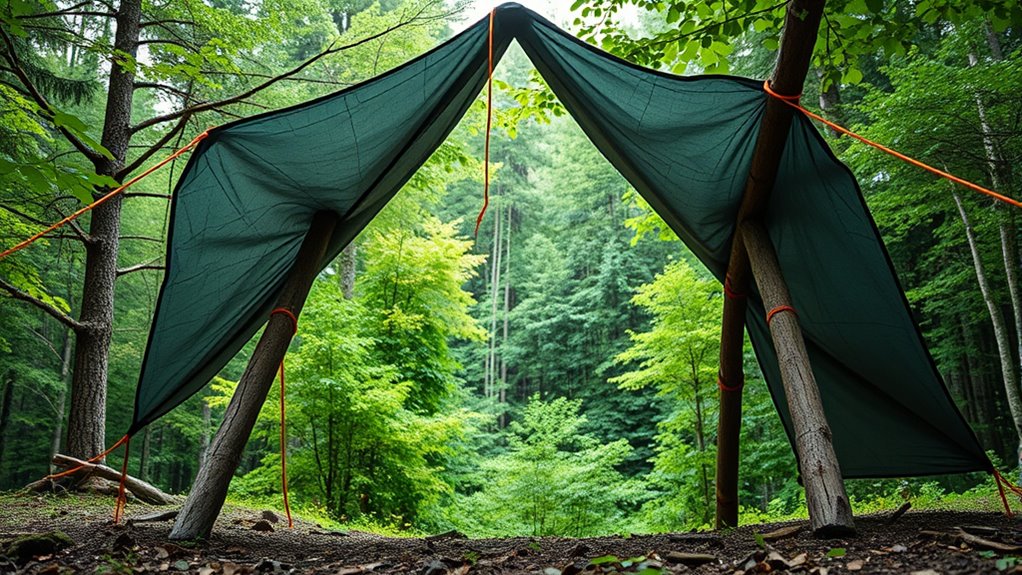To build fast, effective shelters like lean-tos and A-frames, start by choosing sturdy support points like trees, sticks, or natural features. Secure your tarp tightly, staking out edges for rain runoff and wind resistance. Lean-tos are quick and simple, using one support, while A-frames offer more stability and headroom. Practicing these setups helps you stay dry and safe in emergencies—continue exploring how to optimize your shelter for any situation.
Key Takeaways
- Use quick, natural support points like trees or sturdy branches to assemble lean-to and A-frame shelters efficiently.
- Secure tarps tightly with stakes, rocks, or natural anchors to ensure weatherproof stability.
- Construct lean-to shelters by anchoring one edge at ground level and angling the roof for water runoff.
- Build A-frame shelters with two supports forming an A shape, maximizing wind resistance and rain protection.
- Practice assessing surroundings for optimal support points and natural materials to speed setup and improve safety.

When you’re caught in the outdoors and need quick shelter, building a fast tarp shelter is a practical skill that can keep you dry and protected. Knowing how to set up a simple shelter quickly can be the difference between staying warm and safe or facing the dangers of exposure. Among the easiest and most effective options are the lean-to, the A-frame, and basic tarp setups. Each offers a reliable way to create shelter with minimal materials, saving you time and energy while providing adequate protection from rain, wind, and sun.
Quick tarp shelters like lean-to and A-frame keep you dry and protected in emergencies.
The lean-to is the simplest design to master. To build one, find a sturdy support like a tree, a large branch, or a fixed object. Lay your tarp along the support, with one edge anchored securely to the base. Then, stake out the other side, creating a sloped roof. This design sheds water efficiently and is quick to assemble. You can add additional support by tying the tarp to nearby trees or using rocks and stakes to secure the edges. The lean-to is perfect when you’re in a hurry, need quick coverage, or want to conserve space. It works well on uneven ground and can be made more wind-resistant by adjusting the angle or adding extra stakes. Incorporating natural materials like logs or rocks can further enhance stability and insulation.
The A-frame shelter offers a bit more protection and stability. To build it, stretch your tarp over two supporting points, such as trees or sticks arranged in an A shape. Secure the center of the tarp to the ground with stakes or rocks, then stake out the sides to form triangles, creating a ridge at the top. The A-frame design provides good rain runoff and wind resistance, especially when the tarp is tightly secured. It also offers a bit more headroom inside, making it more comfortable for sleeping or resting. For added durability, you can reinforce the ridgeline with a rope or lashings, and make sure the edges are tightly staked down to prevent flapping.
Tarp setups, in general, are versatile and adaptable. You can combine different techniques, like adding an additional tarp for extra coverage or creating an extended porch area for gear storage. The key is using the natural environment—trees, rocks, or existing structures—to anchor your shelter efficiently. Fast shelters don’t need perfect symmetry or elaborate construction; the goal is to create a sturdy, weatherproof cover in minutes. With practice, you’ll learn to assess your surroundings quickly and choose the best setup for the situation. This ability guarantees you’re protected, warm, and dry, giving you peace of mind as you wait out a storm or rest during your outdoor adventure.
Frequently Asked Questions
How Do I Choose the Best Shelter Type for Different Weather Conditions?
You choose the best shelter type by considering the weather conditions you’ll face. For heavy rain and wind, opt for a sturdy A-Frame or lean-to with good waterproofing and wind resistance. If you’re in cold weather, prioritize insulation and windproofing. For hot, sunny days, a tarp or lightweight shelter with ventilation keeps you cool. Always match your shelter to the climate to stay safe, dry, and comfortable.
What Are the Common Mistakes to Avoid When Building Quick Shelters?
When building quick shelters, avoid rushing the setup, as this can lead to weak structures that won’t withstand weather. Don’t neglect securing your shelter properly—use adequate stakes or ties—and make sure ventilation to prevent condensation. Forgetting to assess your environment can be costly; always check for potential hazards like wind or flooding. Finally, don’t leave gaps or openings that let in rain or cold, and double-check your materials for durability.
How Can I Improve Insulation in a Fast-Built Tarp Shelter?
To improve insulation in a fast-built tarp shelter, add a groundsheet to prevent heat loss from the bottom. Use natural insulating materials like leaves or pine needles beneath your sleeping area, and layer extra tarps or blankets inside for more warmth. Make sure your shelter is properly sealed to keep out drafts, and consider creating an air gap between the tarp and your sleeping bag for better insulation.
What Safety Precautions Should I Take During Shelter Construction?
You should always prioritize safety during shelter construction. Investigate whether your tools are in good condition to prevent accidents; sharp or faulty tools can cause injuries. Wear protective gear like gloves, glasses, and sturdy footwear. Be aware of your surroundings to avoid falling objects or unstable structures. Take your time and don’t rush—hurrying increases risks. Double-check your setup before finalizing to guarantee stability and safety for everyone using the shelter.
How Do I Ensure Privacy and Security With Quick Shelter Setups?
You can guarantee privacy and security by choosing a secluded spot away from busy paths or visible areas. Use natural barriers like bushes or trees, or set up a simple privacy screen around your shelter. Lock your shelter’s entrance if possible, and keep valuables hidden or secured inside. Regularly check for any signs of intrusion or wildlife, and stay aware of your surroundings to maintain safety and privacy at all times.
Conclusion
With these quick-build shelters, you hold the power to turn an empty landscape into a sanctuary in moments. Think of your tarp or lean-to as a shield, guarding you against the elements like a mighty fortress. When time is tight and safety is key, these structures become your unwavering allies—simple, strong, and ready to embrace you. In the wilderness, your quick shelter isn’t just a cover; it’s your refuge, your safety, your home away from home.










